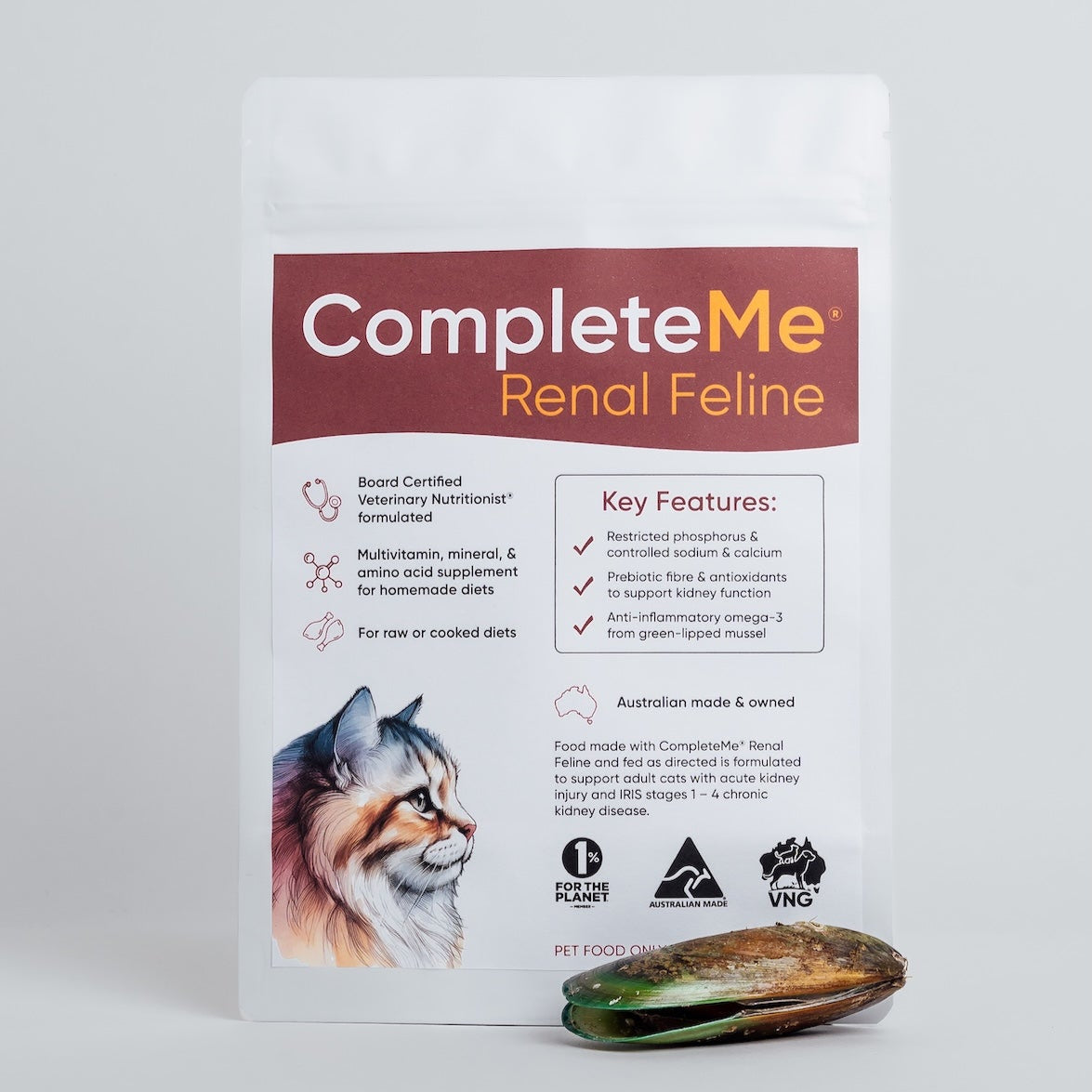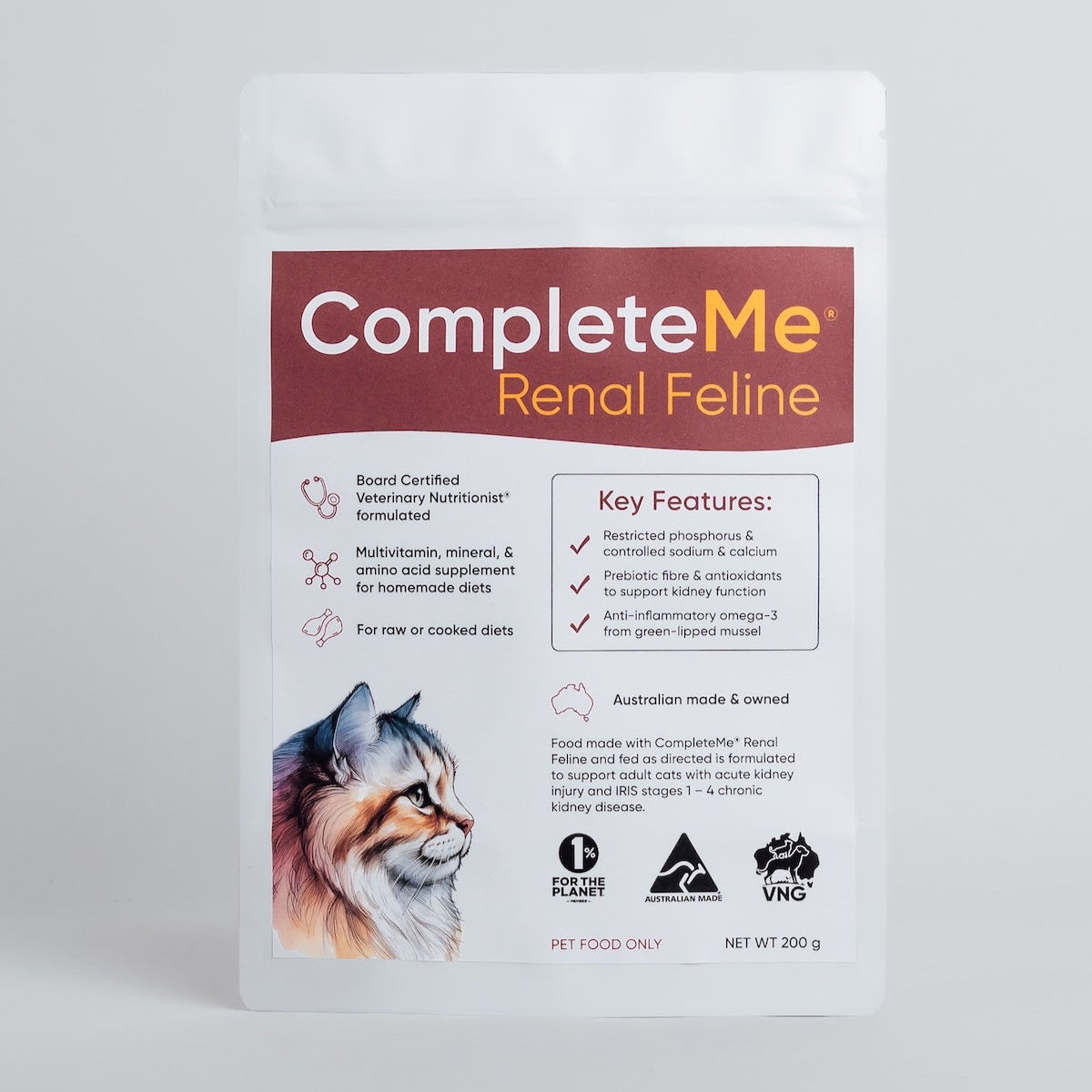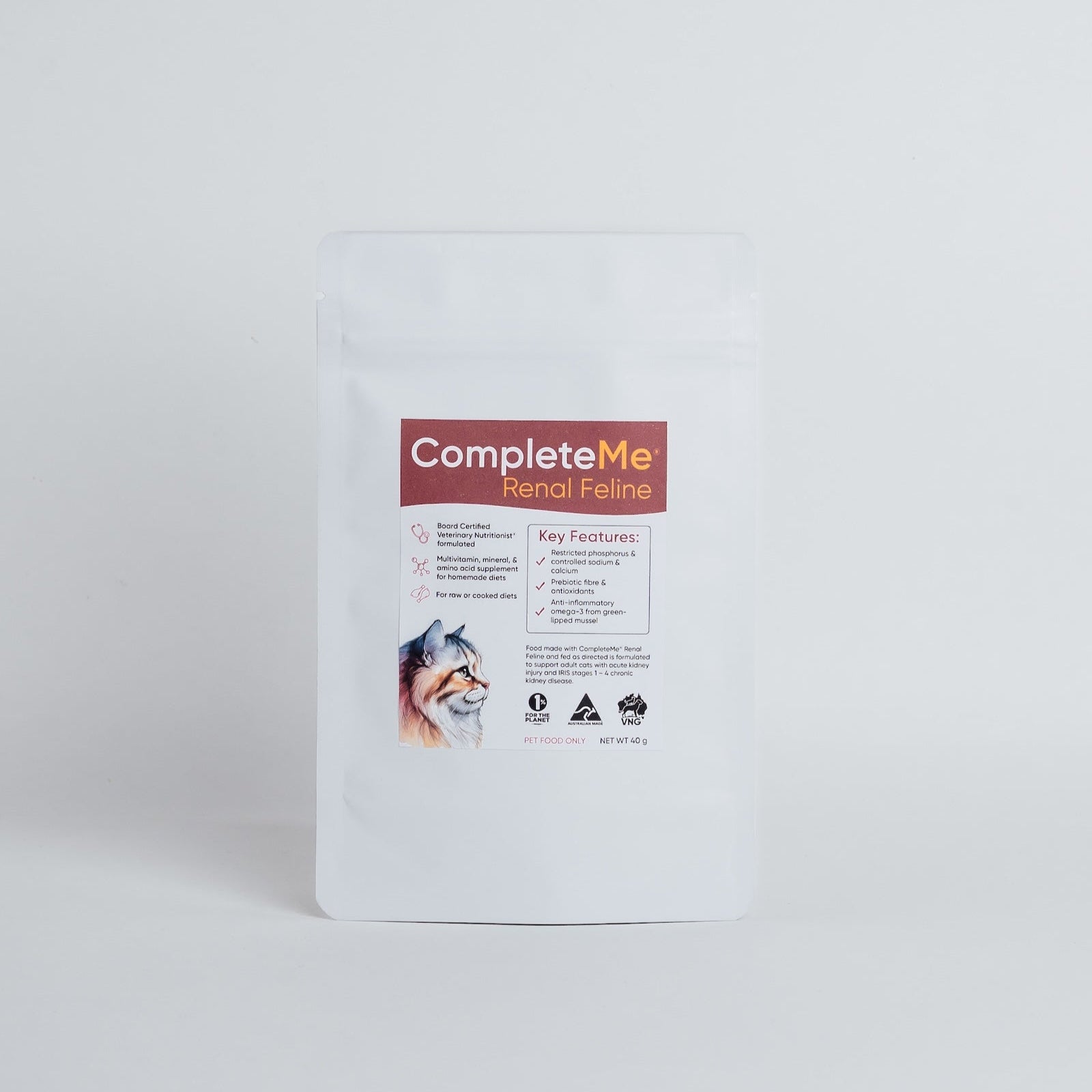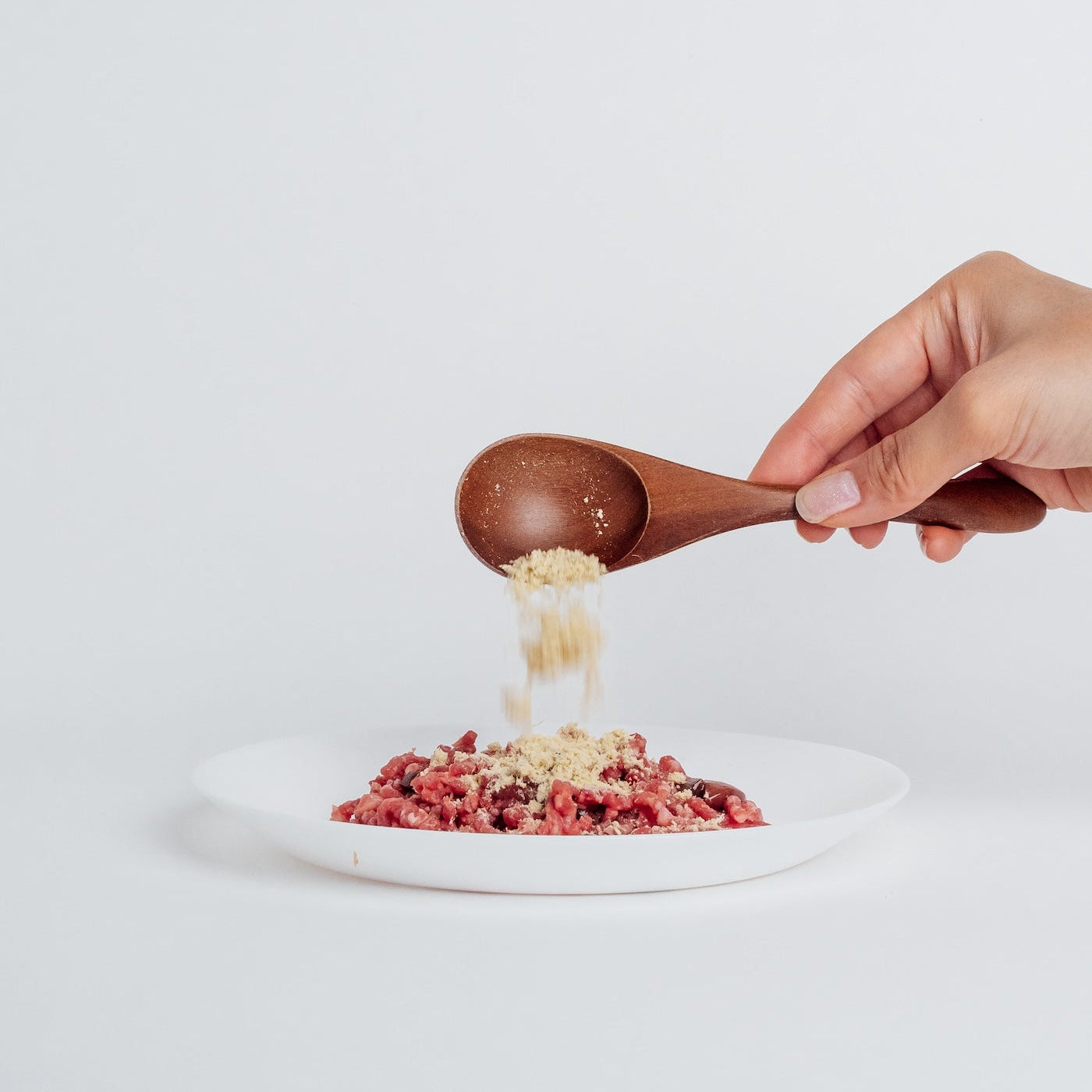
Feeding guide for cats with early kidney disease
With CompleteMe Renal Feline
Make low phosphorus therapeutic cat food at home quickly and easily. Formulated for cats with IRIS stage 1-2 chronic kidney disease.
Choose the meat and other ingredients you would like to use with our simple, flexible guide.
Makes 1 kilogram of food, which can be portioned and frozen.
Ingredients
750 grams of fattier meat (15-18% fat)
Please see the FAQs below for options for meat types and cuts.
250 grams of leaner meat (2-6% fat)
Please see the FAQs below for options for meat types and cuts.
50-100 mL of water or broth
3 mL of omega-3-rich oil (4 x 1000 mg capsules)
(choose from: fish oil, salmon oil, krill oil, marine algae oil)
1 to 3 teaspoons of prebiotic fibre
(choose from: chia seeds, oat or barley bran, psyllium husk, inulin, FOS (fructooligosaccharides), hydrolyzed collagen or gelatine)
30 grams CompleteMe Renal Feline
Optional:
1 level tablespoon of one of the following:
Egg yolk, boneless sardine or mackerel fillets, tasty cheese (full fat), natural yoghurt, finely chopped fresh leafy greens (for example, dandelion greens, rocket).
Directions
Batch prep with raw meat:
- Dice or grind the raw meats, as desired.
- Combine with 30 grams CompleteMe Renal Feline, 50-100 mL water, fibre, omega-3, and any optional ingredients, and mix again.
- Portion and refrigerate, or freeze.
Batch prep with cooked meat:
- Gently cook the diced or ground meats in a pot or slow cooker with 50-150 mL water, until cooked (20-30 minutes).
- Allow to cool, then combine the cooked meat (including liquid from pot), 30 grams of CompleteMe Renal Feline, fibre, omega-3, and any optional ingredients, and mix well.
- Portion and refrigerate, or freeze.
Storage and safety
Use with homemade diets only
Do not add to any commercial cat food, or use with any other nutritional supplements (containing vitamins and/or minerals). Only suitable for adult cats; this diet is not appropriate for growing kittens or reproducing females.
Raw feeding safety
For raw meat, freeze for 10 days before use to destroy parasites like Toxoplasma. In areas with Trichinella, please freeze pork for 3 weeks before use. In areas with highly pathogenic avian influenza, we recommend avoiding raw poultry.
Storage and feeding
Larger batches can be made and frozen for convenience. Keep refrigerated food for 3 days, and frozen food for 3-4 months. Please discard any uneaten food after 30 minutes.
Feeding guidelines
Based on your cat's body weight, these amounts (per day) may be a good starting point:
2 kg: 80-100 g
3 kg: 110-130 g
4 kg: 130-160 g
5 kg: 160-190 g
6 kg: 180-220 g
7 kg: 200-240 g
8 kg: 220-270 g
Cats with medical conditions can have different energy requirements based on their age and stage of disease. Feeding quantities are estimates. The energy density of the diet will change depending on the ingredients you select. Adjust up or down the amount of food based on your cat’s weight changes. We recommend feeding 3-5 meals per day.
If your cat gains unwanted weight, reduce the amount you are feeding by 10% and reweigh after a week. If they have unwanted weight loss, increase the amount you are feeding by 10% and reweigh after a week. Continue to adjust until the right amount of food is determined.
Learn how to quickly body condition score your cat here.
This is a general guideline; please consult with your cat's veterinarian as needed.
Nutritional information
All possible combinations of the ingredients listed above have been checked to ensure that the diet contains moderate protein, restricted phosphorus, controlled calcium and sodium, and is enriched with omega-3 fatty acids, and fibre. Please note, this is a high fat diet.
The specifications for the diet are very similar to commercial early renal diets for cats, like Royal Canin Early Renal and Hill's Prescription Diet k/d Early Care.
The average kcal/gram for the diet is: 1.6 kcal/gram
The average protein on a caloric basis is: 38%
The average fat on a caloric basis is: 62%
Average phosphorus for the diet is:
0.21% as fed basis
0.55% dry matter basis
1.05 g per 1000 kcal ME
Average calcium for the diet is:
0.24% as fed basis
0.68% dry matter basis
1.3 g per 1000 kcal ME
FAQs
What fattier meats can I use?
Chicken:
Boneless thigh or drumstick with skin on, whole chicken with skin (deboned)
Duck:
Boneless breast including fat and skin
Beef:
Mince (15-18% fat), T-bone steak (bone removed, fat untrimmed), scotch fillet steak (untrimmed), porterhouse steak (untrimmed)
Lamb:
Mince (15-18% fat), easy carve shoulder, mid loin or forequarter chops (bone removed, untrimmed)
Pork:
Scotch roast or fillet steaks (untrimmed), mince (15-18% fat), pork and beef mince (15% fat), loin chops (untrimmed)
Venison:
Mince (6-8% fat) PLUS 75 grams of additional fat (choose from raw or rendered animal fats e.g. duck fat, tallow, lard, dripping or raw beef or lamb fat, unsalted butter or ghee, or olive oil (light flavour))
Wild boar:
Mince (6-8% fat) PLUS 75 grams of additional fat (choose from raw or rendered animal fats e.g. duck fat, tallow, lard, dripping or raw beef or lamb fat, unsalted butter or ghee, or olive oil (light flavour))
What leaner meats can I use?
Chicken and turkey:
Skinless and boneless chicken thigh, breast or drumstick, chicken mince (2-3% fat), turkey mince (6% fat), chicken hearts (fat trimmed off), chicken gizzards
Pork:
Rump steak (untrimmed), mince (5% fat), sizzle steaks, loin medallions (fat trimmed off)
Lamb:
Diced or stir-fry strips (5% fat), chump chops, leg steak or rump (fat trimmed off), loin chops or eye of loin, heart (fat trimmed off)
Beef:
Blade, round or rump steak (fat trimmed off), mince (5% fat), veal loin chops (untrimmed), chuck or gravy beef (fat trimmed off), topside roast or steak (fat trimmed off), eye fillet steak (fat trimmed off), cheek (fat trimmed off)
Wild Alaskan pink salmon:
Canned in spring water (entire can contents)
Goat:
Lean diced meat or heart (fat trimmed off)
Kangaroo:
Mince (2-3% fat)
Rabbit:
Wild or farmed rabbit meat (2-5% fat)
Venison:
Shoulder (fat trimmed off), tenderloin or leg steak
Blue mussels:
Cooked only (no shells)
Why combine fatty and lean meats for cats with kidney disease?
Combining lean and fatty meats in a specific ratio allows the diet to meet important nutritional goals for cats with early kidney disease. The target protein content is about 9.5 grams per 1000 kcal ME; all these combinations of meats achieve a similar protein content (9-10 grams). Similarly, the target phosphorus is 1.1 gram per 1000 kcal ME; all combinations also achieve this target (1-1.2 grams).
It is difficult to meet these targets with one meat alone; often the protein or phosphorus is actually too low if the meat is fattier. Restricting phosphorus too much in cats with early kidney disease can increase the risk of hypercalcaemia (high calcium in the blood). Excessive protein may increase uraemic toxin formation, and too little protein may cause muscle loss. It's important to get things just right! With this guide, we have tried to provide flexibility, while also keeping the nutritional features of the diet robust and based on scientific evidence.
Why add omega-3 and fibre to my cat's diet?
For cats with kidney disease, both omega-3 fatty acids (EPA and DHA) and fibre may have a beneficial therapeutic effect. Fibre has been shown to reduce uraemic toxin formation in the gut, and BUN and creatinine may be reduced. Omega-3 fatty acids may reduce kidney fibrosis and DHA in particular may help to protect the kidneys in cats with early kidney disease.
We add both omega-3 and fibre to CompleteMe Renal Feline, however we also recommend adding more to the diet, for a stronger therapeutic effect. In reality, it is difficult to add enough omega-3 and fibre to a meal completer to achieve this, without the supplement becoming unpalatable, expensive and bulky. It's better to add it to the food separately, so you can also adjust the dose as needed and introduce it gradually.
Can I use raw meat?
You can include the meat raw or cooked, depending on preference. For raw human-grade meat, be sure to freeze the meat for 10 days prior to use. For wild-caught meats or pork (in areas with Trichinella, freezing for 3 weeks prior to use is sensible. Please discuss raw-feeding with your cat's veterinarian; raw feeding is not suitable for all cats or households.
My cat needs a moderate to low fat renal diet; what can I do?
This diet is high in fat. Some nutritionists have observed that some cats with pancreatitis may not tolerate a very high fat diet. At the moment, there is no published evidence to support this, however research on this is currently being conducted.
To reduce the fat content of the diet, we can either increase protein or carbohydrate. There is evidence that, even for cats with early kidney disease, feeding excessive protein (more than they need) may increase uraemic toxin formation, and these toxins can cause harm. So, we need to increase carbohydrate.
To do this, please adjust the ratios of ingredients and add a carbohydrate source:
- 500 grams of leaner meat (see FAQ above for options)
- 200 grams of fattier meat (see FAQ above for options)
- 300 grams of cooked white rice or cooked pearled barley (process briefly in food processor after cooking, to break up the grains, as needed)
- 4 mL of omega-3-rich oil
- 1-3 teaspoons of added fibre
- 30 grams of CompleteMe Renal Feline
Please follow preparation instructions above. This produces a diet with the preferred amounts for protein and phosphorus, 35% calories from fat, and 24% calories from carbohydrate. Generally a lower carbohydrate diet would be preferred for cats with diabetes, however some cats may tolerate this amount. Barley would be the preferred option, for its lesser effect on blood glucose (compared with rice).
Is this suitable for cats with diabetes?
Yes, this diet is ultra-low in carbohydrate and can be fed to diabetic cats. Please note that it is high in fat. This may or may not suit some cats with pancreatitis. If you are looking for a moderate fat renal diet, please see the FAQ above.
Is this suitable for healthy older cats without kidney disease?
Yes, food made according to the recipe above can be fed to healthy senior cats, as well as cats with early kidney disease. Phosphorus in the diet is below the AAFCO minimum requirement for adult maintenance (1.25 g per 1000 kcal ME), but above the NRC recommended allowance (0.64 g per 1000 kcal ME). This means that the diet contains adequate phosphorus for healthy adults and will not cause deficiency.
What are some of the most delicious combinations?
Here are some ideas:
- Chicken thigh (skin on) with wild pink salmon
- Pork mince (15% fat) with rabbit meat
- Beef scotch fillet with kangaroo mince
- Duck breast (skin on) with venison shoulder
- Chicken thigh (skin on) and turkey mince (6% fat)
To encourage your cat to eat, try adding a small amount of grated full-fat cheese, crumbled freeze-dried treats, the spring water from a tin of tuna, or commercial treats like Churu. Even if these treats aren't optimal from a nutritional perspective, they can gradually be reduced over time.
What are the lowest phosphorus combinations of meats?
- Chicken thigh (skin on) with beef mince (5% fat)
- Pork scotch fillet (untrimmed) with lean diced lamb (5% fat)
- Beef mince (15-18% fat) with skinless chicken thigh
- Chicken thigh (skin on) with turkey mince (6% fat)
Need to restock?




CompleteMe Renal Feline
CompleteMe Renal Feline contains essential nutrients, omega-3, fibre, and therapeutic compounds to create a balanced renal diet with low phosphorus at home.
Formulated for the management of:
- Early chronic kidney disease (IRIS stage 1-2)
- Advanced chronic kidney disease (IRIS stage 3-4)
- Acute kidney injury
For homemade diets only; not suitable for commercial diets. Suitable for raw or cooked diets, depending on preference.
Must be used with our simple feeding guides to create a therapeutic diet. Choose the meats and other ingredients you would like to use and add CompleteMe Renal Feline to ensure the diet is balanced and appropriate.
Both the product and feeding guides were developed by VNG's two Board Certified Veterinary Nutritionists®, Dr Becca Leung and Dr Meredith Wall.
